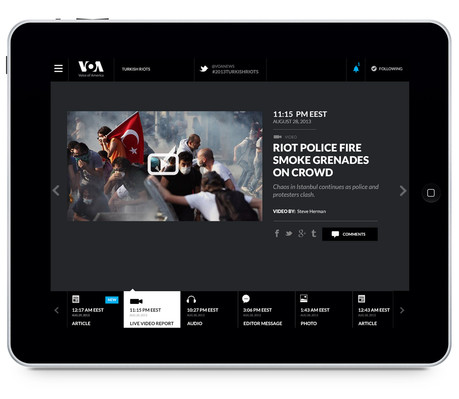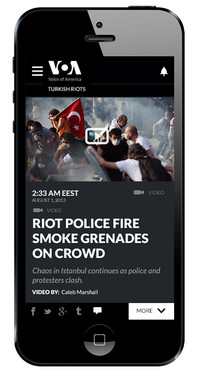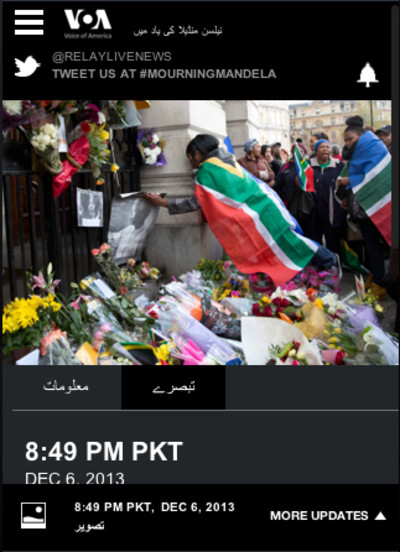
The live blog has been a staple of breaking news situations for the best part of a decade, but for Randy Abramson, director of audio and video products at the US government-supported Broadcasting Board of Governors' (BBG) office of digital and design innovation (ODDI), little has changed.
"Everyone does the same thing," he told Journalism.co.uk. "In those early moments they usually put up a large headline, a few details and then ask people to come back later.
"Then as they get more detail they get a live blog, and I started to think that the live blog hasn't ever really been redesigned. There were some play-by-play live blogs we used to use for concerts and sporting events in the 90s and they looked exactly the same as they do now."
Abramson's experimental alternative is the opensource, mobile-first platform Relay, currently available on GitHub and being tested by reporters and editors around the world.
"The idea was how do we recreate the live blog for the mobile user," he said.
The redesign involves a swipeable 'card' system intended to be intuitive for both the reader and reporter.

Image provided by ODDI
Audience interaction
The first issue, said Abramson, was that once people have been alerted to a breaking news situation, they are unlikely to stay on a live blog for very long, especially if it is not updated regularly.
The problem there though, he said, was that they may miss key updates to the ongoing situation. Relaying information quickly and smoothly was the focus.
"It's a web app, not a native app," he said, explaining how readers would be alerted to the news through social media but would be less likely to download a new app than follow a link to a web page.
"So we did a web app and once they come to the Relay experience they could sign up for email or SMS alerts."
It was equally important to Abramson and his team to make something that readers will be able to understand quickly, based on existing habits or types of user interaction.
"One thing either an eight year-old kid or 70 year-old grandparent knows how to do is flick through photos on iPhoto on their phone," he said, "so we used that same motif and we call them cards."
As such, each piece of content – a picture, video, embedded tweet, text update – has its own card, said Abramson, and readers can flick and swipe through the cards as if it were a gallery.
"The other thing with live coverage is, whether you're looking at it on a live blog or Twitter feed, once you start that commute home you might have missed quite a bit of content and you don't know where you are in the story," he continued, "So we created this timeline element on the bottom so you can figure out where you are in the story and go backwards or forwards within that story."
Readers can flick through the story headlines to catch up on what they may have missed, before expanding on a particular entry to get more detail.
The ODDI team is experimenting with filtering options as well, to just show certain types of content, or provide an "editor's picks" option where the news team can give a recap of the important moments.
"You might have an event with 50 cards," Abramson said, "but after the event is done the editor might say there's only 12 main turning points and you'd be able to hit that button and have the timeline contract to only the highlights."

Image provided by ODDI
Editorial experience
It was equally important that reporters be able to upload content quickly and easily, said Abramson, so the back-end of Relay has been made "input-agnostic", using existing tools and platforms to automatically draw in content from around the web.
"If you have a journalist on the ground who is always very comfortable using Soundcloud for audio interviews you'd be able to input that into the system," he said, "or YouTube has a function where you can email a video to the YouTube channel."
Each event has its own hashtag which reporters would use on specific media files emailed to a Flickr, YouTube or Soundcloud channel set up for the event. Back-end software in Relay watches the channels for the hashtags and automatically adds them to a card for the story.
The text for each card is added from the text fields of the email, said Abramson, with the headline being drawn from the email's subject and the main text from the body.
"If we say 'look, we know you know how to use email, this is something you can use to send reports in via email'," he said. "Whether its embedding a picture, embedding a video, a text update – all those things can be done straight from the phone so we have an army of one-man or one-woman production machines out in the field, armed with equipment that they already know how to use."
For an organisation like the BBG, which runs the international Voice of America (VoA) broadcast outlet in 45 languages around the world, the need for flexibility was paramount in making Relay applicable and accessible to any situation.
"You might have a great reporter who is not comfortable with all the tech tools but they're out in the field and they're trapped somewhere," he said. "The least they could do is a series of text updates from their phone."

Screenshot from Beacon.UrduVoA.com on mobile
The digital team at VoA Urdu were the first to give Relay a live test run, by crowdsourcing reaction to Nelson Mandela's death in Pakistan and collecting responses in the card system.
Abramson understands the platform is not the finished product, but by rolling it out to different organisations and news teams, as well as offering it out on GitHub, the creases are being ironed out.
The VoA team did a recent test run for President Obama's recent State of the Union address, the platform has been picked up by NASA for satellite launches and Abramson said that the VoA Russia and VoA Africa plan to use Relay for the upcoming Sochi Winter Olympics and World Cup in Brazil.
The potential for livestreaming, however, is something he is keen to push, integrating existing platforms into the card system in the same way as with other media and developing a framework for multiple livestreams showing different angles of the same event.
"All the buttons on the bottom could be different camera views of the same event," he said, 'and we don't see anyone else really trying to pull that off except ESPN."
'But from a news perspective, the fact that three reporters can go out with their phones and basically have three different views of an event is really exciting."
With so many stories and competing organisations, Abramson sees the personalisation element of updates and alerts as fundamental to how an audience will interact with news outlets on their mobile devices in the future.
"When a user comes to your site and metaphorically raises their hand and says 'yeah I'm really interested in this story and I trust your brand to keep me updated', I think that is what people are going to be interested in as digital journalism evolves.
"They're going to say 'I don't want to know everything that your brand is doing but I know you're doing an amazing job on this [story], I want to know when you guys have updates and I want to be able to view that experience on any device, from anywhere that I am'. That's a big inspiration for this product."
For more information about Relay, contact Randy Abramson at rabramson@bbg.gov and follow him at @randyabramson
Update: this article has been updated to show that Abramson's title is director of audio and video products, not director of product management and operations, as previously stated.
Free daily newsletter
If you like our news and feature articles, you can sign up to receive our free daily (Mon-Fri) email newsletter (mobile friendly).









